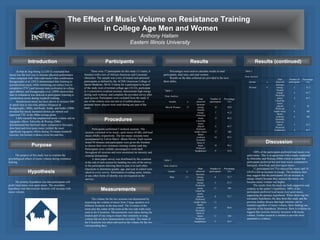
Hallam 2014 research fair poster
- 1. The Effect of Music Volume on Resistance Training in College Age Men and Women Anthony Hallam Eastern Illinois University Participants ResultsIntroduction Procedures Results (continued) Discussion Percentages were used to calculate results in total participants, total men, and total women. Results on the data collected are provided in the next three tables. 100% of the participants preferred loud music over quiet music. This is in agreement with a study conducted by Edworthy and Waring (2006) which revealed that participants preferred fast and loud music compared to fast/quiet, slow/loud, and slow/quiet music. 11 participants (64.7%) enjoyed the music and 10 (58.8%) felt an increase in energy. The similarity here may suggest that the participants felt an increase in energy simply because they enjoyed the music, not because music volume was higher. The results from the study are both supportive and contrary to the author’s hypothesis. 100% of the participants preferred loud music over quiet music, supporting the primary hypothesis. When observing the secondary hypothesis, the data from this study and the previous studies discuss that high intensity can be reached regardless of music volume; these findings are opposite of the hypothesis. However, there is evidence to suggest that exercise intensity increases with music volume. Further research is needed to provide more quantitative evidence. Table 2 Data Analysis Gender n Data observed Number of participants Percentage (%) Men 11 Increase energy 8 72.7 Neutral energy 3 27.3 Preferred music 11 100 Liked the music played 8 72.7 Preferred louder music 11 Better workout 10 90.9 Normally listen to music 11 100 Preferred headphones 5 45.5 Table 3 Data Analysis Gender n Data observed Number of participants Percentage (%) Women 6 Increase energy 2 33.3 Neutral energy 4 66.7 Preferred music 4 66.7 Liked the music played 3 50 Preferred louder music 6 100 Better workout 6 100 Normally listen to music 5 83.3 Preferred headphones 4 66.7 Table 1 Data Analysis Gender n Data observed Number of participants Percentage (%) Men & Women 17 Increase energy 10 58.8 Neutral energy 7 41.2 Preferred music 15 88.2 Liked the music played 11 64.7 Preferred louder music 17 100 Better workout 16 94.1 Normally listen to music 16 94.1 Preferred headphones 9 52.9 Ju-Han & Jing-Horng Lu (2013) concluded that music was the best way to increase physical performance when compared with video and music/video combination. Karageorghis et al. (2013) demonstrated that listening to asynchronous music while swimming can reduce time to completion (TTC) and increase state motivation in college aged athletes, and Karageorghis et al. (2009) showed that time to exhaustion was delayed in participants listening to synchronous music during treadmill walking. Synchronous music has been shown to increase 400- m sprint time in non-elite athletes (Simpson & Karageorghis, 2006), and Rendi, Szabó, and Szabó (2008) revealed that music increased strokes per minute and improved TTC in the 500m rowing sprint. Little research has emphasized music volume and its ergogenic effects. Edworthy & Waring (2006) demonstrated that fast/loud music compared to fast/quiet, slow/loud and slow/quiet music yielded the most significant ergogenic effects during 10 minute treadmill exercise, but limited evidence exists beyond this. There were 17 participants for this study (11 males, 6 females) with a mix of African-American and Caucasian ethnicities. The sample was a mix of trained and untrained participants as defined by the ACSM (American College of Sports Medicine, 2014). Criteria for a participant to be part of the study were of normal college age (18-22), participate in 3 consecutive workout sessions, demonstrate high energy during each workout, and complete the provided survey after each session. Participants were excluded from the study if any of the criteria were not met or if mobile phones or personal music players were used during any part of the study. Participants performed 3 workout sessions. The sessions consisted of no music, quiet music (61db), and loud music (84db), respectively. The two music sessions were accompanied by Calvin Harris’ album Motion. Each session lasted 40 minutes and participants were given the freedom to choose their own resistance training routine each day. Participants were verbally encouraged to work hard throughout all sessions and were monitored on intensity and external distractions. A short paper survey was distributed by the examiner at the end of each session by handing two sets of the survey to the participants allowing them to pass it to each other. Questions to determine gender, age, and year in school were asked in every survey. Information revealing name, initials, or any other forms of identity was not required on the surveys. Measurements The volume for the two sessions was determined by measuring the volume of music from 2 large speakers at 6 different locations in the area used. The 4 corners of the room plus the center of the room at the two side walls were used as the 6 locations. Measurements were taken during the loudest part of one song to ensure that variations in song volume did not skew measurements recorded. The mean of the 6 locations was taken and used as the volume for the two corresponding days. Purpose The purpose of this study was to examine the psychological effects of music volume during resistance training Hypothesis The primary hypothesis was that participants will prefer loud music over quiet music. The secondary hypothesis was that exercise intensity will increase with music volume.